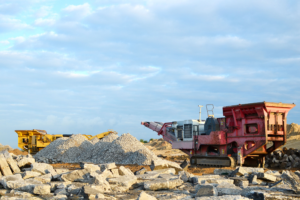Is the Mining ‘Goldilocks’ Phase Just Beginning? What It Means for ASX Miners

A “Goldilocks” phase in the mining sector describes an environment where multiple favourable elements align: commodity prices remain solid yet not extreme, demand fundamentals are supportive rather than collapsing, production costs are under control, and investment risks are manageable. In such a scenario, mining companies generate reliable cash flows, maintain capital discipline, and return value to shareholders rather than merely surviving or chasing speculative growth. For ASX-listed miners, the arrival of such a phase would mean an operating context that’s more stable and constructive compared with either boom exploitation or a deep downturn.
What are the Best Mining stocks to invest in right now?
Check our buy/sell tips
Why conditions appear to be aligning for Australian miners
Several key developments point to the possibility that Australian miners may be entering this favourable phase.
Firstly, the export earnings outlook for Australia’s resources and energy sector indicates important shifts in commodity mix and value. According to the September 2025 edition of the Resources and Energy Quarterly (REQ), the gold export earnings of Australia are projected to reach approximately A$60 billion in 2025–26, supported by higher volumes and elevated prices. At the same time, iron ore continues to dominate the export value, yet its export earnings are forecast to decline from about A$116 billion in 2024–25 to around A$113 billion in 2025–26 and about A$103 billion in 2026-27. That transition in the composition of earnings suggests a structural re-balancing, away from reliance purely on bulk commodities, into precious metals and critical minerals.
Secondly, Australia is favourably positioned in the global energy-transition story. The Reserve Bank of Australia (RBA) notes that Australia’s production of lithium, rare earths and copper is projected to increase strongly over the next five years, with exports of lithium, copper and nickel expected to account for around 10 per cent of Australia’s resource export value by 2030 (up from about 6 per cent today). That opens up an avenue for miners beyond the conventional iron-ore/coal heavy model to benefit from structural tailwinds associated with decarbonisation and electrification.
Thirdly, valuation metrics for the resources sector imply upside potential. While precise forward P/E multiples for all miners are not publicly aggregated for this blog, commentary suggests that valuations have not yet rerated to historic peaks, offering a margin of safety for investors if fundamentals improve.
Fourthly, the broader macro-environment supports a reasonably positive backdrop. While the Australian economy is not booming, the mining export sector remains a cornerstone of external earnings, and a relatively weaker Australian dollar can enhance the translated earnings of miners in AUD terms. During a “just right” phase, the combination of steady demand, cost discipline and favourable currency tailwinds can help.
Finally, mining firms in recent years have demonstrated improved cost discipline, better corporate governance and a stronger shareholder-return focus (dividends, buy-backs) rather than unbridled growth. That structural improvement means when conditions move from constrained to constructive, companies are better placed to capture upside rather than simply riding the commodity wave.
But is this the beginning of the phase, or are we already partway through?
While many indicators point to a favourable shift, it is important to acknowledge both the windows of opportunity and the risks. Export earnings data show that while some commodities are rising, other segments are normalising or declining. For example, the REQ forecasts total resources and energy export earnings for Australia to decline from around A$385 billion in 2024–25 to about A$369 billion in 2025–26, and further to A$354 billion in 2026–27. That indicates a structural moderation rather than a precipitous collapse or runaway boom.
On the demand side, major consumers such as China continue to face challenges (slow steel demand, property-sector weakness), which weigh on bulk commodities. Supply expansions in certain commodities also create headwinds for pricing. For instance, while critical minerals have growth potential, the RBA emphasises that the outcome is not guaranteed and depends on technology, policy and supply-chain developments. In short, many of the underlying factors suggest the early stage of a favourable environment rather than the peak of a super-cycle. The question for investors is whether that favourable environment will hold, and whether management execution and external demand will deliver.
What this phase implies for ASX-listed miners and investors
With the possibility of a “Goldilocks” phase emerging, how should investors interpret that for ASX-listed mining stocks?
Firstly, company quality and execution become paramount. In a moderate upward turning cycle (rather than a speculative boom), mining companies that deliver low all-in sustaining costs (AISC), strong cash-flows at current price levels, disciplined capital allocation and robust balance sheets are better positioned. Investors should favour producers with established operations, low debt and a clear shareholder-return policy over those solely focused on growth or exploration.
Secondly, the commodity exposure mix matters significantly. In this phase, exposure to precious metals (especially gold) and critical/battery metals appears more favourable than relying exclusively on bulk commodities whose structural headwinds are more pronounced. The gold export earnings forecast (A$60 billion in 2025-26) highlights the attractiveness of gold-focused miners. Additionally, lithium export earnings are forecast to grow from over A$4.8 billion in 2024–25 to over A$6.1 billion in 2026–27. In contrast, iron-ore earnings are expected to decline as the price normalises despite volume growth. That suggests miners with diversified commodity exposure or those in higher-margin segments may outperform.
Thirdly, valuation and margin of safety become important. While the sector appears mildly undervalued relative to historical norms (implying potential re-rating), valuation alone cannot suffice. Selecting miners with credible project pipelines, low operating risk, and favourable exposure to promising commodities is vital. A margin of safety cushions against execution risk, cost inflation and commodity-price surprises.
Fourthly, timing and risk management remain critical. Even if the “just-right” phase is beginning, the mining sector remains subject to shocks – global demand declines, supply surges, regulatory changes, cost inflation, and currency moves. Investors should diversify across commodities and companies, monitor key catalysts (production ramp-ups, commodity guidance, policy changes), and not chase the highest-risk miners simply because sentiment improves.
Technology & Market Movers: The Apple Event and What It Means for Tech-Angle Exposure
A relevant and timely factor for investors is the upcoming Apple event. Apple has confirmed an annual fall product launch on 9 September 2025, where the company is expected to unveil the new iPhone 17 series alongside updated Apple Watches and other devices. Further, rumoured for a possible second event in October are major product updates, including the M5 chip-powered iPad Pro and refreshed MacBooks.
For the ASX tech exposure, this matters for a few reasons:
A strong Apple ecosystem rollout often stimulates supplier, component and device-manufacturing demand globally. Australian tech/semiconductor supply-chain companies may benefit indirectly from such global momentum.
The broader sentiment in technology markets can be buoyed by flagship announcements; that ripple effect may extend to IT, hardware, battery or mining companies with tech overlap.
If Apple demonstrates strong innovation, execution and consumer demand, technology valuations tend to lift, providing a positive tilt to portfolios with tech exposure and possibly prompting diversification away from purely commodity-driven assets.
Thus, while the primary focus remains mining, investors with diversified portfolios should keep an eye on global tech-events such as Apple’s, because they can influence risk appetite, market rotation and where capital flows next.
Key risks that could derail a favourable mining phase
Despite encouraging signs, several risks threaten to derail the “Goldilocks” scenario. One major risk is demand weakness in China and globally. Australia’s mining sector benefits significantly from Asian demand, particularly from China’s steel industry and infrastructure spending. A prolonged slump in Chinese demand would challenge miners focused on bulk materials like iron ore, coal and certain base metals.
Another risk is commodity-price and supply surprises. For example, technological innovation, substitution, recycling or new supply can undermine price assumptions. With critical minerals, while the structural logic is strong, significant supply expansions and cost pressure could dampen returns. The RBA’s caution on critical minerals underscores this. Cost inflation is another risk – labour, energy, equipment, and regulatory compliance all remain volatile. If cost growth outpaces productivity or commodity-price increases, margin erosion is possible.
Regulatory, environmental and community risks also carry weight. In Australia, large-scale projects frequently face permitting delays, cost overruns, Indigenous-land and community engagement issues, as well as royalty/tax reform risk. For miners, failure to manage these risks may blunt returns. Valuation overshoot risk is a subtler but real concern. Even in favourable phases, valuations can run ahead of fundamentals. Over-hyped exposure to weak assets or speculative plays may disappoint if execution or market conditions falter.
Strategic approach for mining exposure
Given that a constructive phase may be starting for the mining sector, a prudent strategic approach for investors might include the following.
Allocate selectively to a diversified mining basket: For example, a large-cap producer with strong margins and dividend discipline; a mid-cap gold-producer with rising precious-metal exposure; and a smaller specialist in battery/critical minerals with high optionality (and higher risk). This blend gives exposure to the up-cycle while managing idiosyncratic risk.
Focus on companies with strong execution: Prioritise miners that provide clear cost guidance, maintain manageable debt levels, and return capital to shareholders rather than expanding indiscriminately. Avoid those heavily leveraged to volume growth without margin visibility.
Overlay commodity-outlook fundamentals: Use public data such as the RE Q, RBA bulletins, industry analyst forecasts and company reporting to test assumptions. For example, lithium export earnings are forecast to increase, signalling an opportunity in that segment. Use these inputs to calibrate expectations and weighting in your portfolio.
Monitor key catalysts and inflexion points: These might include mine permitting, production ramp-ups, cost-curve shifts, changes in key consumer demand (especially China), currency movements, and corporate M&A activity in the mining sector. These events often serve as catalysts for equity re-rating or downside risk realisation.
Maintain margin of safety and manage expectations: Even if a favourable phase is starting, mining stocks remain volatile and rarely deliver linear returns. Returns may accrue over multiple years rather than deliver quick gains. Avoid over-concentration in speculative miners without established operations, especially where execution risk is elevated.
Final thoughts
The Australian mining industry appears to be entering a potentially favourable “Goldilocks” phase, where demand fundamentals, favourable commodity segments, cost discipline and prudent capital allocation align to offer a constructive outlook. For ASX-listed miners, this could translate into a context in which stable returns, operational improvement and shareholder-value creation are more likely than in a deep downturn.
However, there is no guarantee that this phase will play out smoothly. Execution risk, demand softness, supply dynamics, regulatory frameworks and cost pressures all remain real threats. For investors, the opportunity lies in positioning ahead of the cycle, but success will be driven by selectivity, discipline and awareness of risk, rather than commodity exposure alone.
If it suits, a follow-up could include a ranked list of specific ASX-miners, comparing their cost profiles, balance-sheet strength and exposure to favourable commodities, helping to identify which companies might be best positioned for the “just-right” phase.
FAQs
- What does the term “Goldilocks phase” mean in mining?
The term “Goldilocks phase” refers to a balanced period where commodity prices, demand, and costs are all favourable, not excessively high or low, allowing mining companies to earn strong margins and steady returns.
- Which commodities are expected to perform best during this phase?
Gold and critical minerals such as lithium, copper, and rare earths are projected to benefit most, supported by energy-transition demand and rising investment in renewable technologies.
- How could the “Goldilocks” phase impact ASX-listed mining stocks?
If the phase continues, ASX-listed miners may enjoy higher profitability, improved dividends, and potential re-rating of valuations, particularly for companies with strong cost discipline and exposure to growth commodities.
- What are the key risks that could end this favourable phase?
Major risks include a slowdown in Chinese demand, oversupply in critical minerals, rising operational costs, and regulatory and environmental challenges that increase project delays and expenses.
- Are Australian mining stocks currently undervalued?
Based on historical valuation metrics, many resource stocks trade below long-term average price-to-earnings multiples, suggesting some undervaluation, though careful stock selection remains crucial.
Blog Categories
Get Our Top 5 ASX Stocks for FY26
Recent Posts
Develop Global Wins $200m OceanaGold Contract- What It Means for Investors
Develop Global (ASX: DVP) climbed 4% to A$4.36 on Friday after securing a A$200 million underground development contract with global…
Nova Minerals Drops 14% on $20m Capital Raise- Buy or Avoid?
Nova Minerals (ASX: NVA) dropped nearly 14 per cent to A$0.90 following the announcement of a US$20 million (approximately AUD…
WiseTech (ASX:WTC) Rises After Richard White Cleared of Misconduct – Should You Buy the Dip?
WiseTech Global (ASX: WTC) climbed 3 per cent to A$70.18 on Friday after founder and Executive Chairman Richard White was…



